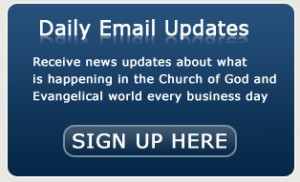Church Growth Todays Releases 100 Largest Churches List
America’s small churches under 400 attendance still dominate the nation’s church landscape both in number of churches and in total attendance. The number of the smaller churches still make up more than 90 percent of all U.S. congregations. John Vaughan (photo), founder of Church Growth Today research and consulting in Springfield, Missouri, has listed and ranked both America’s 100 largest and 100 fastest growing evangelical and Protestant churches since 1980. His 2016 Church Growth Today 100 largest churches list also includes the 200 fastest growing churches by actual attendance gain (net). Average weekend attendance for the 100 largest churches list begins at 9,000 and the 200 largest churches list begins at 6,000 attendance.
While most smaller churches with less than 1,000 will never become megachurches, they can be encouraged that churches their size can actually have more overall attendance gain (i.e. net) than many megachurches. In the Church Growth Today 100 fastest growing churches list actual gain begins at 500 people and the 200 fastest growing churches list begins at an annual gain of 200 in weekend attendance.
These two lists reveal that actual attendance gain is not the exclusive domain of megachurches who can have great growth but have more losses than gains. A church’s ability to multiply new leaders and new groups, in proportion to their size, can be a major factor. Creation of additional worship services may increase attendance but involvement in groups retains the new growth. Smaller churches tend to have fewer additional services and are able to assimilate a higher percentage of their attendance gains. So smaller churches can excel as they reach new people and care for existing members.
That said, the actual average attendance of the smallest among America’s 100 largest churches has experienced seismic gains since year 2000. A top 100 church that had 4,000 attendance could be among the 100 largest churches but by 2010 needed 8,000 to be among that group. The average size doubled mostly due to the addition of multi-site locations created by new churches and three in four of the largest churches. Multi-site churches, among these evangelical, Protestant, and non-affiliated gatherings, increased by 10 percent (up from 66 percent in 2010).
There were 329 multi-site campuses in 2010 compared to 511 in 2015 (a gain of 182 sites or 64 percent). Ten of the 2015 churches each reported having 10 or more multi-site campus worship locations. Life.Church of Edmond, Oklahoma, has 70,000 attending 21 locations (micro-churches) in seven states. Christ the King Church in Burlington, Washington, has at least 23,400 in their small church groups network.
The Wesleyan denomination has a Native American Lakota pastor, Larry Salway of He Sapa New Life Church (Rapid City SD), reaching 7,437 people in nearly 300 house churches scattered over a 250 mile area. A first among American tribal groups. They also minister to tribal groups in Alaska, Washington State, New York and Arizona. That represents a lot of changed lives.
The number of multi-site churches drops to almost half among the 200 largest churches (75% among America’s 100 largest churches to 65% among the 200 largest churches.). The largest church in the nation, Houston’s Lakewood Church led by Joel Osteen, is the largest of the single-site churches and largest American church under one roof with 52,000 weekend attendance (44,800 in 2010). Single –site churches total 24 among the 100 largest churches and 69 churches among the 200 largest congregations. Multi-site churches have more than a 100 year history in North America. When Vaughan wrote his book, The World’s 20 Largest Churches (1985), nine of the 20 churches were multi-site churches.
Major shifts are trending among both small churches and American megachurches. These are seismic shifts since the 1980 book, The Complete Book of Church Growth (1981), by Elmer Towns and John Vaughan announced 2,000 attendance could include a church among the 100 largest churches. That was the first book to list the 100 largest churches in worship attendance, membership, Sunday school enrollment, Sunday school attendance, fastest growing Sunday churches, and income.
(Source: Christian Newswire)




